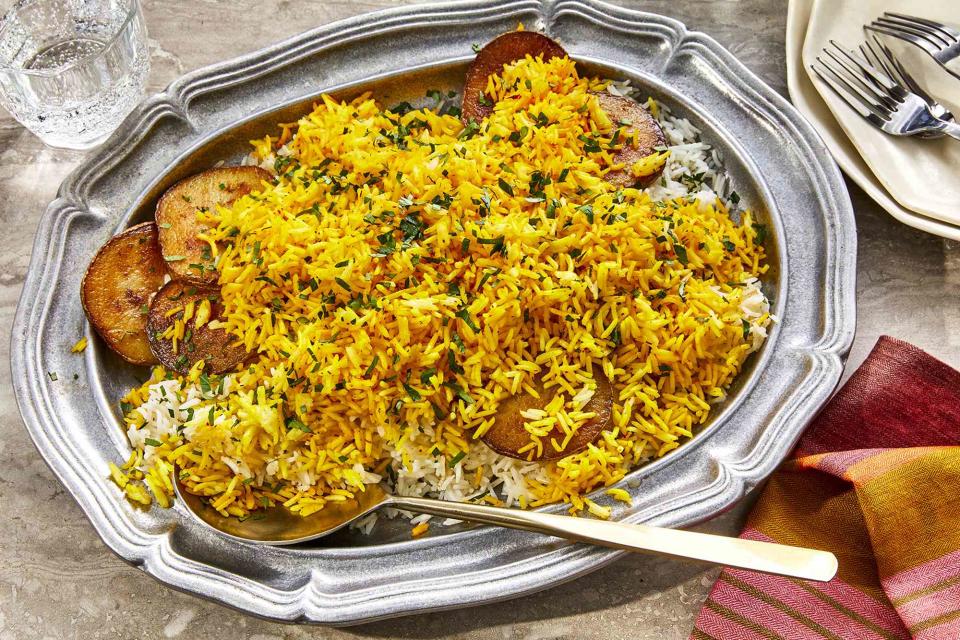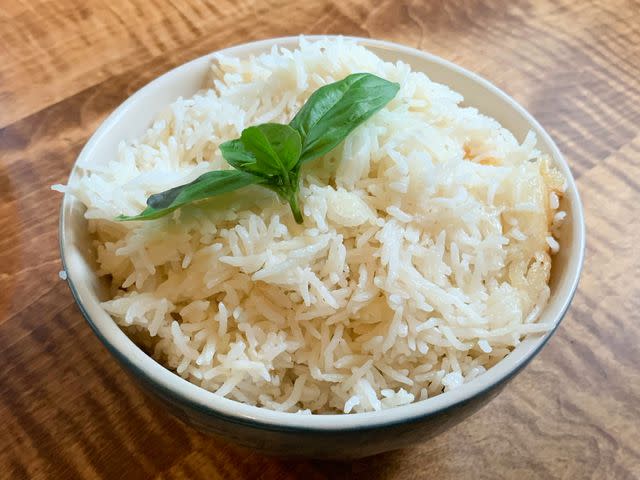Basmati Rice vs. Jasmine rice: What's the Difference?
Get to know these two aromatic rice varieties and how to best use each.

Have you explored the selection of rice in your grocery store lately? The options have expanded to include arborio rice, basmati rice, black rice, bomba rice, and jasmine rice to name a few.
Basmati rice is known for an ease of cooking and a nutty, floral aroma. Jasmine rice is available in a variety of colors that include white, brown, black, purple, and red. If you're looking to compare basmati rice and jasmine rice, you will see that they look quite similar. Both are varieties of long-grain white rice, but they are, in fact, very different ingredients.
Related:Our 53 Best Rice Recipes of All Time
Basmati is a go-to for making a pilaf, biryani, plov, or the classic Persian dish called chelow. This variety also commonly serves as a base for curry. Jasmine rice is what shoppers usually look for when picking up ingredients for fried rice, com do (Vietnamese red rice) and hung kao mun gati (Thai coconut rice).
Read on for more about these versatile rice varieties and how you can use both in your kitchen.
What Is Basmati Rice?

Basmati rice has a name that derives from the Sanskrit word basamati, which means “fragrant.”
Basmati rice is a North Indian variety of rice grown in the foothills of the Himalayas. This rice can be described as having a nutty flavor with a hint of floral notes. Many chefs and home cooks like working with basmati rice because it has a long grain that is slightly tapered at the end.
When shopping for basmati rice, you might see basmati that is grown in the U.S., such as “Texmati” and “Kasmati.” Only the basmati rice from the traditional growing region of Northern India and Pakistan can be called basmati.
Basmati is naturally delicate and produces a relatively small yield, which makes it labor-intensive and a costly food product to produce. In order to keep prices low, some growers have tried to breed a sturdier basmati with a higher yield.
The rice can be steamed in a double-boiler which prevents any burning or rice sticking to the bottom of the pan. The rice can also be made in a traditional rice cooking method using a rice-to-water ratio, and cooking until the water has been absorbed. Alternatively, it can be prepared like pasta, where the rice is cooked in the water and then drained.
Chefs and home cooks find basmati rice to be a reliable grain to use in a wide variety of dishes. It becomes fluffy when cooked, yet the grains stay nicely separated; this means the rice is easily coated. When basmati rice cooks it elongates to almost twice its size and works well in dishes like a curry or dal.
The health benefits for basmati rice? The grains are gluten-free and low in fat. The rice is also low in sodium, cholesterol-free, and contains all eight essential amino acids and folic acid.
What Is Jasmine Rice?

Jasmine rice is a long-grain variety of fragrant rice also known as aromatic rice. The rice’s scent is the fragrance of a plant called pandan; it also gives off the aroma of buttered popcorn. (Yes, please!)
Steamed jasmine rice can be served plain as a side dish, to accompany curries or other dishes, or infused with other flavors or herbs. Jasmine rice can also be used as a base for dishes in a pilaf or fried rice combination.
It is a popular part of Southeast Asian cooking where people might use this rice in several dishes throughout the day.
Jasmine rice, which is native to Thailand, has grown in popularity with American consumers. Unlike other white rice varieties, jasmine rice gives off a delicate floral scent that is highly prized in Thailand. The purest form of the rice is known as Hom Mali which means "good smelling."
When compared with other varieties of long-grain rice varieties available in stores, jasmine rice tends to cook up relatively soft and sticky with a delicate but firm chew. The rice contains less amylose — a starch that resists water — and gelatinizes at lower temperatures than varieties like basmati. This means that the grains will deconstruct at a lower temperature.
Jasmine rice, with a texture of a slightly chewy grain that maintains a fluffy and soft feel, benefits from being steamed and is most commonly served with curries and wok dishes like krapow, as well as in rice-based dishes like fried rice and biryani chicken rice.
Basmati Rice vs. Jasmine Rice in Cooking
Both basmati and jasmine rice are long-grain varieties of rice that require a rinse before being cooked. Their grains also remain distinct, although jasmine is a bit plumper and softer than basmati, which has a drier chew to the rice.
The different textures and starch content between the two guide how each type of rice is cooked.
Basmati rice should be soaked for at least 30 minutes before being boiled. Jasmine rice, on the other hand, is ready to be steamed after it is rinsed. Because it is a softer variety of long-grain rice, it doesn't require soaking and requires less water. A typical ratio is 1 cup rice to 1 1/4 cups water.
So, can these two popular rice varieties be used in place of each other? Despite their distinct textures and aromas, basmati and jasmine rice are often used interchangeably.
Related:5 Mistakes You're Making When Cooking Rice
Basmati rice can be paired with tender proteins and savory sauces that are able to thoroughly saturate the rice. This helps to bring out the natural nuttiness of the grain. Chicken and lamb biryani are great examples. Basmati grains will remain distinct and fluffy and maintain their long and slim shape.
Jasmine rice holds up well in soups and stews and pairs well with seafood and vegetables more so than a hefty protein like steak or pork. Jasmine rice has a plush and firm chew with grains that can collect in small clumps, making it a good rice to eat with chopsticks.
Both basmati and jasmine rice are fragrant ingredients that offer endless versatility. Get to know their qualities and you’ll likely find yourself incorporating them in any number of your favorite recipes.

